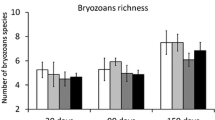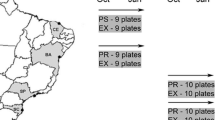Abstract
Acrylic panels were employed to follow fouling community development at Channel Points, Lynnhaven Bay, Virginia, from April 1977 through March 1979. Panel treatments were devised to study the effects of predator exclusion and panel area on community development. An additional panel was introduced in April 1978 to test the repeatability of initial community development. Early development was similar both years with hydroids, barnacles, and the polychaetePolydora ligni the initial macroinvertebrate colonists. Early community development in both years was dominated by the solitary tunicateMolgula manhattensis. Molgula was able to invade and rapidly overgrow all resident speices except largeBalanus eburneus. Panel area was shown to affect the community structure and development. The community on caged panels (predator exclusion) was significantly different from controls, although the differences could not be unequivocally attributed to predation.
Similar content being viewed by others
Literature Cited
Calder, D. R., andM. L. Brehmer. 1967. Seasonal occurrence of epifauna in Hampton Roads, Virginia.Int. J. Oceanol. Limnol. 1:149–164.
Connell, J. H. 1961a. The influence of interspecific competition and other factors on the distribution of the barnacleChthamalus stellatus.Ecology 42:710–723.
Connell, J. H. 1961b. Effect of competition, predation byThais lappillus, and other factors on natural populations of the barnacleBalanus balanoides.Ecol. Monogr. 31:61–104.
Connell, J. H. 1972. Community interactions on marine rocky intertidal shores.Ann. Rev. Ecol. Syst. 3:169–192.
Dayton, P. K. 1971. Competition, disturbance, and community organization: the provision and subsequent utilization of space in a rocky intertidal community.Ecol. Monogr. 41:351–389.
Fuller, J. L. 1946. Season of attachment and growth of sedentary marine organisms at Lamoine, Maine.Ecology 27:150–158.
Graham, H. W., andH. Gay. 1945. Season of attachment and growth of sedentary marine organisms at Oakland, California.Ecology 26:375–386.
Haderlie, E. C. 1968. Marine fouling organisms in Monterey Harbor.Veliger 10:375–386.
Haderlie, E. C. 1969. Marine fouling organisms in Monterey Harbor II. Second year of investigation.Veliger 12:182–192.
Jackson, J. B. C. 1977. Habitat area, colonization, and development of epibenthic community structure, p. 349–358.In B. F. Keegan, P. O. Ceidigh, and P. J. S. Boaden (eds.), Biology of Benthic Organisms. Pergamon Press, New York.
Karlson, R. H. 1978. Predation and space utilization in a marine epifaunal community.J. Exp. Mar. Biol. Ecol. 31:225–240.
Long, E. R. 1974. Marine fouling studies off Oabu, Hawaii.Veliger 7:23–36.
Maloney, W. E. 1958. A study of the types, seasons of attachment, and growth of fouling organisms in the approaches to Norfolk. Virginia, U.S. Navy Hydrographic Office, Tech. Rep. 47. 35 p.
McDougall, K. D. 1943. Sessile marine invertebrates of Beaufort, North Carolina.Ecol. Monogr. 13:321–374.
Menge, B. A. 1976. Organization of the New England rocky intertidal community: role of predation, competition, and environmental heterogeneity.Ecol. Monogr. 46:355–393.
Nair, N. B. 1967. The settlement and growth of major fouling organisms in Cochin Harbour.Hydrobiologia 30:503–512.
Orth, R. J. 1971. Observations on the planktonic larvae ofPolydora ligni Webster (Polychaeta: Spionidae) in the York River, Virginia.Chesapeake Sci. 12:121–124.
Osman, R. W. 1977. The establishment and development of a marine epifaunal community.Ecol. Monogr. 47:37–63.
Paine, R. T. 1966. Food web complexity and species diversity.Am. Nat. 100:65–75.
Pomerat, C. M., andE. R. Reiner. 1942. The influence of surface angle and light on the attachment of barnacles and other sedentary organisms.Biol. Bull. 82:14–25.
Pomerat, C. M., andC. M. Weiss. 1946. The influence of texture and composition of surface on the attachment of sedentary marine organisms.Biol. Bull. 91:57–65.
Redfield, A. C., andB. H. Ketchum (eds.) 1952. Marine fouling and its prevention. U.S. Naval Inst., Annapolis, Md. 388 p.
Richards, B. R., andW. F. Clapp. 1944. A preliminary report on the fouling characteristics of Ponce DeLeon tidal inlet, Daytona Beach, Florida.J. Mar. Res. 5:189–195.
Scheer, B. T. 1945. The development of marine fouling communities.Biol. Bull. 89:103–121.
Standing, J. D. 1976. Fouling community structure effects of the hydroidObelia dichotoma on larval recruitment, p. 155–164.In G. O. Mackie (ed.), Coelenterate Ecology and Behavior. Plenum Press, New York.
Stoecker, D. 1978. Resistance of a tunicate of fouling.Biol. Bull. 155:615–626.
Sutherland, J. P. 1974. Multiple stable points in natural communities, Am. Nat. 108–873.
Sutherland, J. P. 1975. Life histories and the dynamics of fouling communities, p. 137–153.In J. D. Costlow (ed.), The Ecology of Fouling Communities: U.S.-U.S.S.R. Cooperative Program. Office of Naval Research.
Sutherland, J. P. 1977. Effect ofSchizoporella (Ectoprocta) removal on the fouling community at Beaufort, North Carolina, USA, p. 155–176.In B. C. Coull (ed.), Ecology of marine benthos. Univ. South Carolina Press, Columbia.
Sutherland, J. P. 1978. Functional roles ofSchizoporella andStyela in the fouling community at Beaufort, North Carolina.Ecology 59:257–264.
Sutherland, J. P., andR. H. Karlson. 1973. Succession and seasonal progression in the fouling community at Beaufort, North Carolina, p. 906–929.In 3d Int. Congr. on Marine Corrosion and Fouling. Northwestern Univ. Press, Evanston, Ill.
Sutherland, J. P., andR. H. Karlson. 1977. Development and stability of the fouling community at Beaufort, North Carolina.Ecol. Monogr. 47:425–446.
Virnstein, R. W. 1977. The importance of predation by crabs and fishes on benthic infauna in Chesapeake Bay.Ecology 58:1199–1217.
Virnstein, R. W. 1978. Predator caging experiments in soft-sediments: caution advised, p. 261–273,In M. L. Wiley (ed.) Estuarine Interactions, Academic Press, New York.
Wisely, B. 1959. Factors influencing the settling of the principal marine fouling organisms in Sydney Harbour.Aust. J. Mar. Freshw. Res. 10:30–44.
Woodin, S. A. 1974. Polychaete abundance patterns in a marine soft-sediment environment: the importance of biological interactions.Ecol. Monog. 44:171–187.
Author information
Authors and Affiliations
Rights and permissions
About this article
Cite this article
Otsuka, C.M., Dauer, D.M. Fouling community dynamics in Lynnhaven Bay, Virginia. Estuaries 5, 10–22 (1982). https://doi.org/10.2307/1352212
Issue Date:
DOI: https://doi.org/10.2307/1352212




